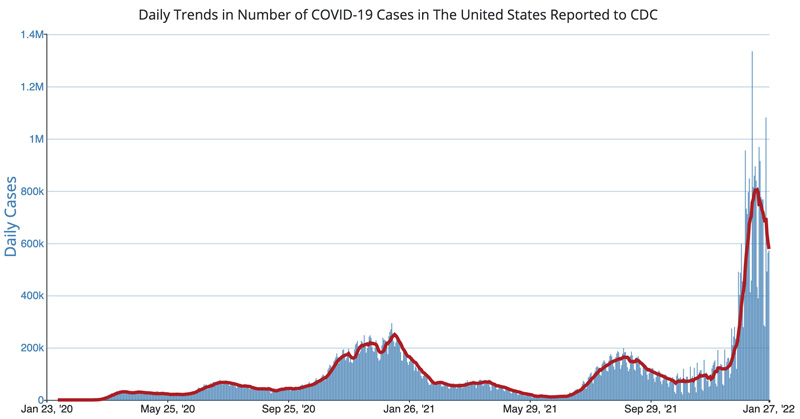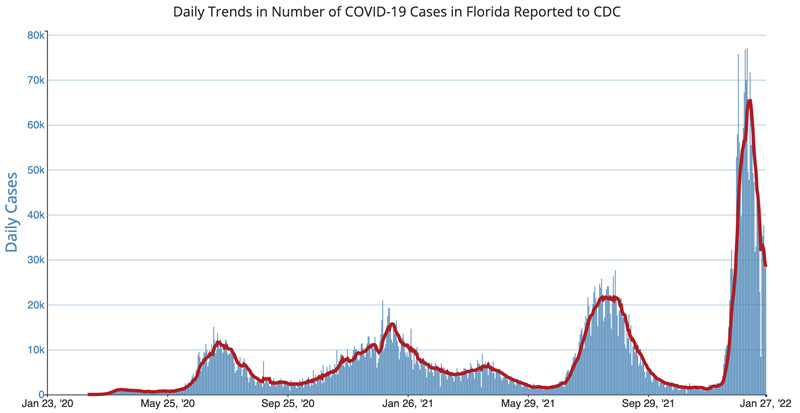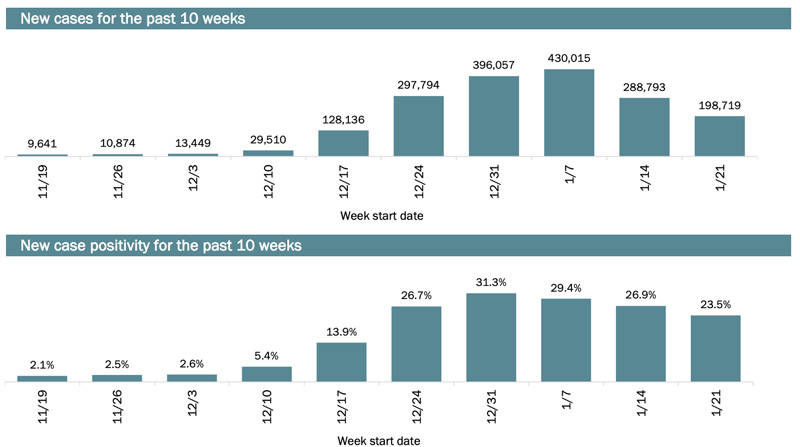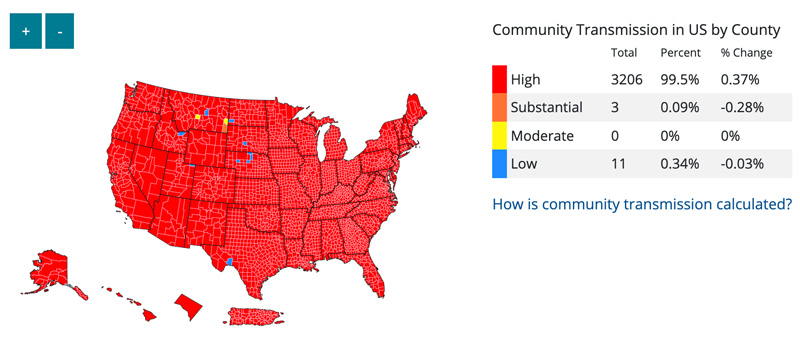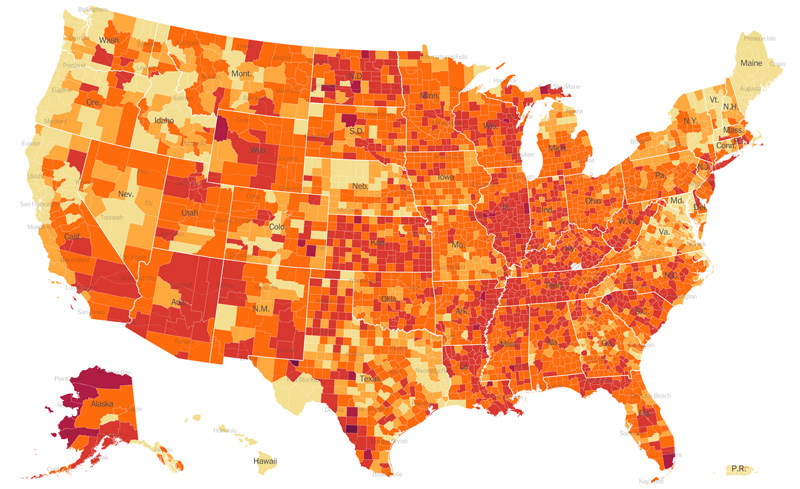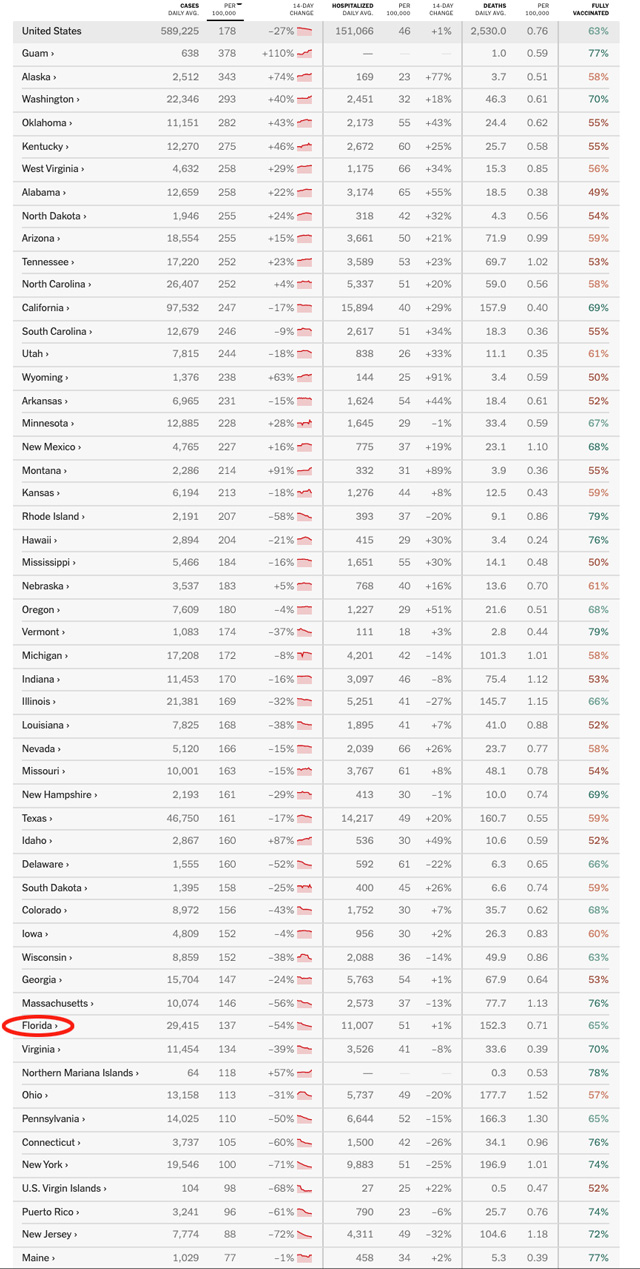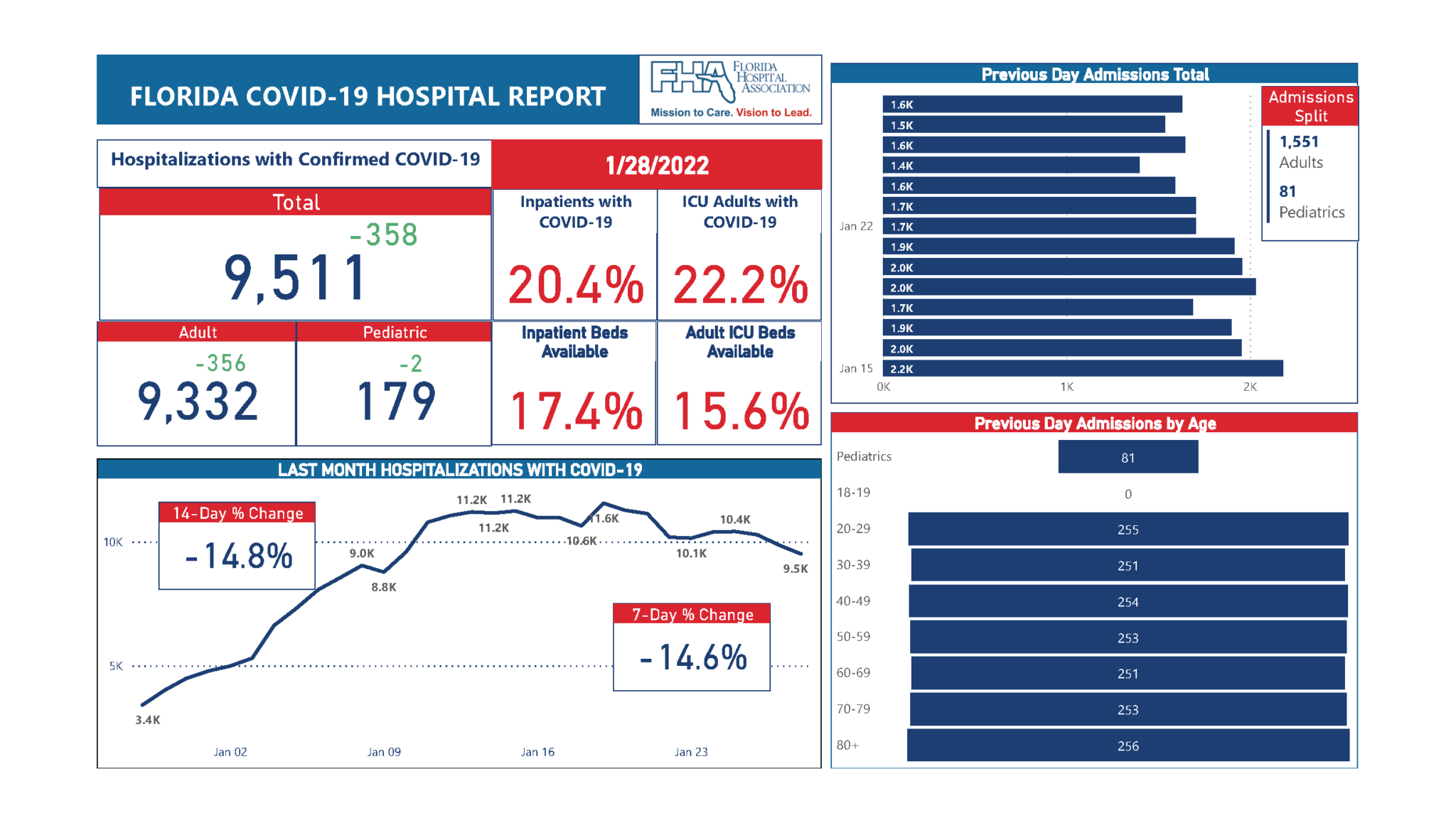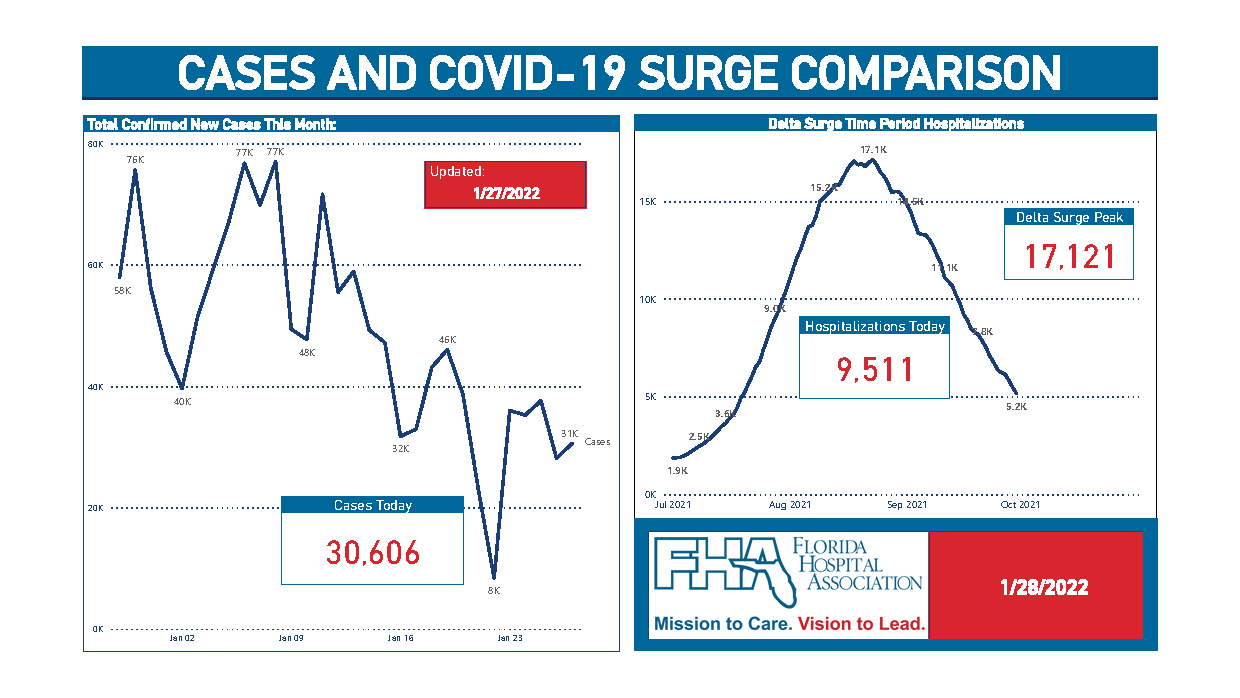Omicron Cases Fall Fast in Florida
We’re back with another COVID-19 report covering new case, positivity, and hospitalization data from Orange County as of January 28, 2022. It’s another optimistic update, as the Omicron surge has peaked throughout the United States and is now falling fast in Florida. All of the data, plus expert commentary when it’ll be appropriate to life rules, such as mask mandates.
Let’s dig right into the data, which is presented in table form above. Per the Centers for Disease Control, the number of daily COVID-19 cases has peaked in the United States, with 572,524 new cases reported on January 28, 2022 (for yesterday), which brings the 7-day rolling average down to 577,748.
This is the lowest level since January 5, and down from the record daily average of 804,404 new cases on January 15. In the approximately two weeks since hitting that high, numbers have fallen dramatically. This reflects the same sharp up followed by a steep downward trend observed in other countries that got hit hard by Omicron before the United States.
For its part, Florida reported 30,606 new COVID-19 cases on January 28, 2022 (again, for yesterday), which is the 7th consecutive day of tallies in the thirty-thousands or below. The rolling 7-day average now stands at 28,392 cases, which is down from 41,267 exactly one week ago.
Here’s a look at the U.S. Centers for Disease Control data table showing Florida’s sharp decline:
Just to put things into context, this average is still higher than during the peak of the Delta wave when average numbers topped out around 21,000 per day, last holiday season’s surge, or any point in the last two years.
Nevertheless, there’s a lot of reason for optimism as this number has been trending downward for over two full weeks now, offering ample evidence that the Omicron wave has peaked in Florida. And that’s not the only metric that has peaked.
This is also not simply a result of reduced testing. Statewide positivity rates dropped from 31.3% the week of 12/31 to 23.5% this past week (1/21-1/27).
Testing positivity rates are still anything but “good,” but they are trending in the right direction–and fast. Nevertheless, they’ve soared from their pre-Omicron levels in the 5% range (as recently as the week of 12/10), to what the CDC considers “uncontrolled spread” now. Hopefully the downtrend happens as fast as the spike.
Orange County’s average positivity rate currently stands at 28.09% (down from 35.61% last week), which is still firmly in the red/high tier of the CDC’s Community Transmission Map.
As you can see, the vast majority of the United States is in the high tier. Just as the CDC has modified other policies and guidance as the pandemic has evolved, this criteria could change soon. It was originally crafted when population immunity was lower and cases were more closely connected to hospitalizations.
Another positive development is that Florida is once again improving as compared to other states for average daily cases over the past week with 137 per 100,000 people. That’s down 54% in the last two weeks, which is a pretty sizable drop, roughly on par with the decreases in the Northeast.
As you can see from the chart below, many states are still increasing by or more during the last two weeks as Omicron didn’t hit all states on the same timeline–and some others were still in the midst of their Delta waves up until the holiday season. By contrast, those that got hit early by Omicron–like New York, New Jersey, Maine, Massachusetts, Georgia, and Florida–have already seen the worst of the wave.
For anyone who would like to take a deeper dive into the data, consult the below resources for numbers reported and compiled by local, state, and national organizations:
- Florida Department of Health Weekly Situation Report (Updates Fridays) – A great resource for statewide vaccination, positivity and case numbers, including stats over the last 10 weeks. Also gives cumulative and weekly numbers for each county in the state.
- United States Centers for Disease Control and Prevention’s Data Tracker (Updates Daily) – The authoritative resource for case, death, and testing trends for the United States as a whole, and each individual state. (Florida does not provide data on weekends.)
- New York Times Hot Spot Map & Case Counts – The New York Times compiles data from state, local, and federal health agencies to create a map of hotspots, and trends among the states.
- Johns Hopkins University Data Resource Center – Good for data junkies, or those who want to visualize trends.
- U.S. Department of Health and Human Services Hospital Utilization – Only truly useful when things get bad, as it shows available hospital capacity. (Also worth reviewing on occasion when things are good, as doing so provides context as to normal capacity numbers for local hospitals.)
- Florida Hospital Association Daily Report – This gets posted daily to Twitter; I assume there’s also an official site where it’s compiled, but I haven’t been able to locate that, so I just refer to the official account.
Arguably the most useful data at this point is hospitalization utilization. After a period of plateauing, hospitalizations have been on a sustained downtrend for the last week. The number of hospitalizations with COVID-19 (there’s still no statewide distinction between patients who are hospitalized with COVID as opposed to because of COVID) fell below 10,000 on January 28, 2022 to 9,511.
Currently, 20.4% of inpatient hospital beds in Florida are in use by patients with COVID-19 (down exactly 5% from one week ago) and 22.2% of ICU beds are in use by patients with COVID-19 (down 3% in the last week). Not only is this trending downward, but it’s also significantly lower than the peak of the Delta wave, as you can see in the surge comparison below.
During the Delta wave, hospitalizations peaked at 17,121. That’s despite daily case numbers topping out at around 21,000 versus an average of 80,000 cases during the crest of the Omicron wave. So roughly 4x the case numbers but almost half the hospitalizations.
As previously discussed, there has been a decoupling between cases and hospitalizations in places where Omicron was detected early and has progressed further. In particular, South Africa and the United Kingdom have had nowhere near the level of hospitalizations as during prior waves. The same has now also proven true in the Northeastern and Southern United States, both of which are now past-peak.
Nothing noteworthy in the way of on-the-ground reports this week (although we have no data to support this, it would seem that Walt Disney World got hit hard by Omicron between Christmas and the first two weeks of January and has rebounded since). In addition to that, most of the experts I follow appear to live in the Northeast, and are pretty preoccupied with the bomb cyclone approaching there.
However, Dr. Scott Gottlieb, the former commissioner of the U.S. Food and Drug Administration did an interview this morning on MSNBC, which is above. During that, he said infection levels are “going to continue to come down as we get into the spring and the summer” and that there’s nothing on the horizon that significantly alters that trajectory. He said that even though Delta surprised us, the situation now is different. There’s much more population immunity and a broader composition of Delta and Omicron infection-induced natural immunity, plus vaccinations.
He went on to say that the United States needs to “prescribe very clear goalposts for how we take these mitigation measures off. When do we lift vaccine mandates, when do we stop using masks in schools. As conditions improve, we should be willing to relax these provisions that have created a lot of acrimony, particularly masks in schools, as we try to get back to some semblance of normalcy. We should be as aggressive in lifting these things as conditions improve as we were about putting them in place. That’s also going to preserve the authority of public health officials to reimplement some measures in the future, if in fact this does return next winter.”
Dr. Gottlieb has made similar statements for the last few weeks on CBS Face the Nation, and many of the non-sensational epidemiologists with social media presences have also endorsed lifting mitigation measures and mandates. Some states and countries (United Kingdom being a prime example) are doing this already. Of course, this doesn’t mean Walt Disney World will be as aggressive in lifting its indoor face mask rules, which were reintroduced at the end of last July right as Delta began hitting Florida.
Walt Disney World reinstated its indoor mask rule with that CDC guidance, so it’s likely Disney won’t lift the rule until Orange County qualifies for the moderate level once again. It’s also a safe bet that Walt Disney World won’t lift the current mask rules until there’s a sustained downturn throughout the United States (not just in Florida), which might not happen until March 2022.
It’s also possible that CDC guidance will change between now and then, as the current community transmission metrics are outdated, having been determined prior to current vaccination and immunity levels. Omicron significantly changed the equation, which should be self-evident when comparing cases v. hospitalizations. Speaking of which, I’ll leave you with this recent op-ed from one of the most respected voices during the pandemic: Our playbook to fight covid-19 is outdated. Here are 10 updates for 2022.
Planning a Walt Disney World trip? Learn about hotels on our Walt Disney World Hotels Reviews page. For where to eat, read our Walt Disney World Restaurant Reviews. To save money on tickets or determine which type to buy, read our Tips for Saving Money on Walt Disney World Tickets post. Our What to Pack for Disney Trips post takes a unique look at clever items to take. For what to do and when to do it, our Walt Disney World Ride Guides will help. For comprehensive advice, the best place to start is our Walt Disney World Trip Planning Guide for everything you need to know!
